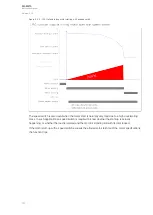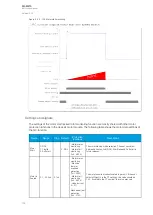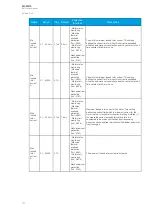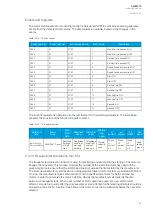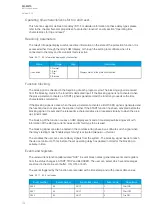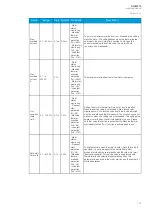
Events and registers
The motor start/locked rotor monitoring function (abbreviated "LCR" in event block names) generates
events from the detected motor status. The data register is available, based on the changes in the
events.
Table. 5.3.9 - 73. Event codes.
Event number
Event channel
Event block name
Event code
Description
3648
57
LCR1
0
Max. Start time exceed ON
3649
57
LCR1
1
Max. Start time exceed OFF
3650
57
LCR1
2
Set start time exceed ON
3651
57
LCR1
3
Set start time exceed OFF
3652
57
LCR1
4
Speed Switch not received ON
3653
57
LCR1
5
Speed Switch not received OFF
3654
57
LCR1
6
Start ON
3655
57
LCR1
7
Start OFF
3656
57
LCR1
8
Set time Trip ON
3657
57
LCR1
9
Set time Trip OFF
3658
57
LCR1
10
Max cap Trip ON
3659
57
LCR1
11
Max cap Trip OFF
3660
57
LCR1
12
Blocked ON
3661
57
LCR1
13
Blocked OFF
The function registers its operation into the last twelve (12) time-stamped registers. The table below
presents the structure of the function's register content.
Table. 5.3.9 - 74. Register content.
Date and
time
Event
code
Start
stall
time
Max. time
used
Set time
used
Thermal
cap.
used
L1
current
L2
current
L3
current
SG
used
dd.mm.yyyy
hh:mm:ss.mss 3648-3661 Descr.
Recorded
duration
of stall/
start
Percentage
used from
max safe
stall time
Percentage
used from
user set
max time
Thermal
capacity
used
Phase
L1
current
x I
n
Phase
L2
current
x I
n
Phase
L3
current
x I
n
Used
setting
group
5.3.10 Frequent start protection (N>; 66)
The frequent start protection function is used for monitoring and preventing the starting of the motor to
happen too frequently. This function monitors the number of the starts the motor has used within a
given time frame to ensure that the start stress does not exceed the limits stated by the manufacturer.
The start-up situation is most stressful normal operation situation for motors that are started with Direct
On Line; the manufacturer gives safe start limits with a specified time frame for both cold and hot
motors in order to guarantee the motor's lifetime. Usually the manufacturers also specify the time
between consequent starts. When a set number of starts have been used or a new start or start
attempt is made too quickly after the previous start or start attempt, further starting attempts should be
blocked by using the N> function, thus allowing the motor to cool down sufficiently before the next start
attempt.
A
AQ
Q-M210
-M210
Instruction manual
Version: 2.04
144








